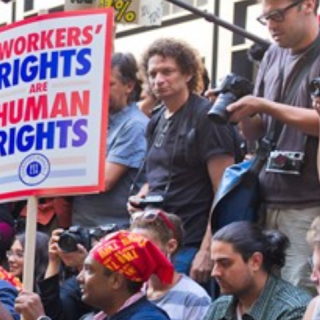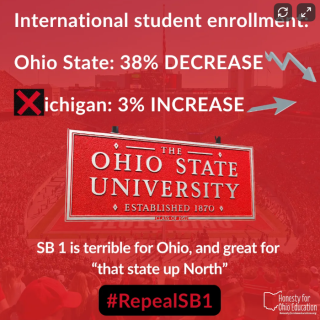Will the Oct 18 No Kings protests equal or surpass the 5 million who marched last June? Trump’s poll numbers keep dropping with his escalating attacks on democracy. People are hungrier than ever for ways to act and resist. And the huge Jimmy Kimmel victory should create resistance momentum. But when I look at the major national days of protest since the original No Kings, I see organizing and communications breakdowns that make their impact less than it could have been. And we want them to be as large and broad as possible.
One problem is Trump opponents relying too much on self-organizing. Groups or individuals use tools like the Mobilize maps to call a demonstration, post time and location, and then assume people will show up: If you build it, they will come. But this can replace the hard work of building coalitions, engaging people to participate, and directly coordinating efforts.
It’s also hard to know which are the major events. For Oct 18, I went to the No Kings map that all the groups link to and punched in my Seattle zip code. It came up with two neighborhood events plus two more general ones with similar enough descriptions to be largely indistinguishable. Later I saw a utility pole flier for the one that had mentioned Indivisible peripherally, and discovered that the sponsors also included SEIU, Planned Parenthood, League of Women Voters, and three major state-wide activist organizations. That’s a major coalition. But when if first clicked to RSVP there was no way of knowing that. And even after the host group belatedly added a link to the larger list of sponsors, the only way I found that out was clicking the RSVP page again.
I then entered the zip codes for Detroit, Philadelphia and Atlanta. They all had just one main center-city event listed, plus suburban events, so that was less confusing. New York City had two in Manhattan and separate Brooklyn and Queens events. So again less confusion. But even if you clicked through, the main events all just said “volunteer organized,” giving no clue to the large coalitions organizing them. If people don’t know whether an event is organized by three random friends or a dozen major groups, it’s hard to know which to attend. Friends throughout the country have mentioned a similar confusion.
I suspect that’s one reason for the drop-off since the original No Kings events. Seattle’s No Kings demonstration had over 50,000 people. But since then, no Seattle demonstration has turned out more than a few thousand, and multiple events have divided attendance—we had three different Labor Day “Workers Over Billionaires” events.
The drop-off has happened with all the subsequent national protest days, important as they’ve been. No Kings Day had over 2,000 events, drawing over 100,000 in Boston, Chicago, Los Angeles, and San Francisco, 50,000 or greater in a half dozen more, and at least 10,000 in 45 cities. Since then, we’ve seen coordinated protests for the anniversary of John Lewis’s death, for Labor Day, and for the Sun Day renewable energy events. The John Lewis anniversary had 1600 events and Labor Day and Sun Day each had hundreds. Their breadth has been powerful, reaching into communities nationwide. But the numbers have been significantly less than the original No Kings. From what I can find, Chicago Labor Day had 10,000 people, maybe a bit more. Austin had 5,000 people as part of a day of events challenging Texas redistricting. Others have had several thousand, although some have been highly creative, like a Portland Oregon Sun Day event that brought together 30 groups for a renewable energy festival and a parade across a downtown bridge that might have also had higher numbers. The original No Kings numbers were larger in part because the events were a counterpoint to Trump’s military parade, which helped with advance media coverage. But while I’m seeing all sorts of notices for the new No Kings, the necessary organizing since last June seems to have been more scattershot, with fewer fully engaged coalitions, and more reliant on the maps. When multiple competing events post without clear information on who is sponsoring them, it’s hard for people to know where to attend, or whether to attend at all. And when they list multiple recognizable sponsors then it makes it more likely for people to go, because it feels like you’re part of a movement where people are working together with power and momentum. It certainly felt that way at the first No Kings Day.
Lots of powerful resistance is going besides those major protests and rallies. More modest rallies in smaller suburbs and towns, and local neighborhoods, have underscored that opposition is everywhere. Protests at Tesla dealerships, Sinclair TV stations, and challenges to ICE have made a difference even when the numbers are modest. There are some critical fall elections and people are getting out the vote The Jimmy Kimmel campaign was an important victory as multiple groups sent out alerts, entertainers stood in solidarity, and ordinary people pressured local stations and advertisers, including attending local vigils.
But national protest days still play an important role for building a sense of common power and solidarity, inspiring local news coverage, and bringing people together for further action. If we want them as successful as possible, organizers need to do more to:
- Make clear which are the main events in their cities, so supporters can focus organizing attention, and participants know which to attend.
- Press Mobilize to adad a field for endorsements and co-sponsors, where hosts could enter multiple organizations. When I corresponded with one of their staffers, she said it would take multiple groups requesting it for them to make it happen.
- If Mobilize doesn’t do that, highlight the larger potential rallies on other ways, including in the text on the Mobilize postings, so members know which ones to attend.
- Coordinate on the ground. Affiliates of the national groups need to be working with local labor, environmental, civil rights, social justice, and faith groups. And then asking members to text, call, and email their friends, so invitations come from trusted messengers.
- Post fliers or posters on lamp posts to complement digital outreach with a physical advance presence.
- Collect contacts at every event to plug random new participants into future efforts, for instance by using QR codes. Then work together continually, not just for major events.
Given the Trump regime’s threats to democracy, October 18 should be a key moment for pushing back and building further momentum. Our tools and approaches should serve this purpose as effectively as possible.
------------------------------
Paul Rogat Loeb is the author of Soul of a Citizen and The Impossible Will Take a Little While, with nearly 300,000 in print between them. Sign up for his Substack here.
En Español
El engaño de “Convócales y vendrán”: ¿Los mapas desplazaron la organización?
¿Pueden las protestas No Reyes programadas para el 18 de octubre superar la cifra récord de cinco millones de manifestantes que salieron a la calle el junio pasado? Las encuestas de popularidad del presidente Trump siguen en declive, debido a sus crecientes e inverosímiles ataques a la democracia. La gente está más hambrienta que nunca para encontrar maneras de actuar y resistir. Y la victoria de Jimmy Kimmel (en revertir ser despedido como cómico crítico) impulsará acciones de resistencia.
Sin embargo, desde mi óptica, los principales días nacionales de protesta posteriores a la primera concentración No Reyes fallaron en cuanto a la organización y formas de comunicación que mermaron su impacto potencial.
Por un lado los que oponen al trompo confiaron demás en la autogestión. Los grupos e individuos usan herramientas como los croquis de la aplicación Mobilize como herramienta para convocar a concentraciones: publican hora y lugar, y dan por sentado que con ello la gente se presentará, así no más “convócales y vendrán”. Pero esta práctica puede desplazar el trabajo de hormiga arduo en construir alianzas y coaliciones que involucran a la gente de manera personal que les fomente a participar y coordinar los esfuerzos por voluntad propia.
Por otro lado, resulta complicado saber cuál es el evento principal. Cuando abrí el croquis de No Reyes para el 18 de octubre que viene, vi los vínculos a todas las organizaciones e individuos convocantes. Para localizar el evento más cercano, capturé debidamente mi código postal en Seattle donde radico. Me aparecieron dos eventos en mi rumbo, más de otros dos eventos más genéricos que tienen descripciones tan similares que imposibilita distinguirlos.
Tiempo más tarde me topé con un volante pegado a un poste de luz para el evento que de paso mencionaba al movimiento Indivisible, pero en él me enteré que entre los patrocinadores figura el Sindicato Internacional de Trabajadores de Servicio (SEIU), Planificación Familiar (PP), la Liga de Lectores Féminas (LWV) y tres de las principales organizaciones activistas en el estado —lo que representa una alianza de peso—. Sin embargo, cuando piqué por primera vez con mi ratón confirmando mi asistencia, no hubo forma de saber de dicha alianza. Incluso después de que el grupo anfitrión añadiera tardíamente el enlace con la lista completa de patrocinadores, me enteré sólo porque refresqué la página de confirmación.
Por curiosidad ingresé códigos postales de Detroit, Filadelfia y Atlanta; hubo un evento medular anunciado en los centros de estas ciudades, más otros en sus conurbios, así que no fueran tan confusos. Nueva York, en cambio, tenía dos en Manhattan y eventos por separado en los distritos de Brooklyn y Queens —así que, hasta allí, mayor claridad—. No obstante, cuando piqué los enlaces para mayores informes, no decían más que “organizado por voluntarios” sin ninguna pista sobre las coordinadoras amplias que los organiza. Si el lector no esté enterado de antemano que lo convocan tres almas perdidas o un frente amplio con docenas de organizaciones nacionales, se queda en las mismas sin saber a cuál elegir. Mi gente allegada en todos los rincones del país externa quejas similares.
Estoy de la idea que esta falta de transparencia figura entre los motivos principales por los que la participación ha caído desde los eventos No Reyes originales. La primera manifestación No Reyes en Seattle reunió a más de 50,000, pero de ahí en adelante ninguna protesta en Seattle rebaza los pocos miles. Y peor, la diversidad de eventos diluya la asistencia; por ejemplo, en el Día del Trabajo tuvimos tres diferentes eventos, todos bajo la misma la consigna de “Trabajadores sobre Millonarios”.
Consideramos que la primera protesta No Reyes convocó a más de dos mil eventos, con una afluencia que rebasó los cien mil en las ciudades de Boston, Chicago, Los Ángeles y San Francisco; más de cincuenta mil en medio docena de ciudades y por lo menos diez mil en cada una de 45 otras. Desde aquel parteaguas, la participación ha caído en los días de protesta nacional, por importantes que fueron el aniversario luctuoso de John Lewis, el Día del Trabajo, y los eventos de energía renovable en Día del Sol. La cantidad de eventos también retrocede: mil seiscientos en el aniversario de John Lewis y cientos en los Días del Trabajo y del Sol. Su alcance ha sido poderoso, permeando a comunidades en todo el país. Pero la asistencia se merma: las estadísticas disponibles reportaron diez mil en Chicago el Día del Trabajo, cinco mil en Austin que denunciaba la manipulación de distritos electorales en Texas.
A pesar de una loable creatividad que debería atraer a grandes confluencias, otros eventos apenas alcanzan unos miles de asistentes, como fue el Día del Sol en Portland, Oregón donde 30 organizaciones aliaron para festejar la energía renovable y desfilar a través de un puente del centro. Claro que es, el No Reyes original coincidía con —y desafiaba— el desfile militar inédito de Trump que atrajo amplia cobertura mediática previo al evento. De todas maneras, aun cuando me llega toda clase de anuncio para la siguiente emisión de No Reyes, la obligatoria organización parece ser más dispersa desde junio, con menos coaliciones plenamente comprometidas y a la vez más dependientes de las aplicaciones de mapeo.
Cuando se anuncia múltiples eventos simultáneos sin mayor información clara sobre los patrocinadores, es difícil para la gente saber dónde asistir —o siquiera asistir—. Es decir, ver múltiples organizadores reconocidos es lo que convence a la gente a acudir porque se siente parte de un movimiento que cobra fuerza trabajando hombro con hombro y llevando la batuta. Innegable es que el primer Día de No Reyes instó esa sensación.
Al margen de esas protestas y manifestaciones masivas, fluye una amplia resistencia poderosa. Manifestaciones modestas en conurbes, pueblos y vecindarios demuestran como la resistencia permea la sociedad norteamericana. Ejemplos claros que marcan la diferencia son las protestas en agencias de Tesla, estaciones de televisión Sinclair y desafíos a ICE, incluso cuando la asistencia es modesta. La campaña de Jimmy Kimmel fue una victoria clave, ya que varios grupos se metieron de lleno para circular alertas, artistas mostraron su solidaridad y las personas comunes presionaron a las estaciones locales y anunciantes, incluso con vigilias locales.
Recordamos que se avecina un periodo electoral crítico y que la gente se moviliza para sufragar.
Todo lo anterior no significa que las manifestaciones numerosas no juegan un papel medular en instar un sentido de poder y solidaridad comunitaria, sino que se reditúan en cobertura por noticieros locales, en un círculo virtuoso que inspira mayor confluencia para acciones continuas. En pos de mayor éxito, lo organizadores deben seguir las siguientes recomendaciones:
Transparentar cuál evento es el principal en su localidad, para que los partidarios se enfocan la atención y los participantes sepan a cuál acudir.
Exigir a la aplicación Mobilize agregar un campo para patrocinadores y copatrocinadores donde los organizadores puedan captar múltiples convocantes. A mí me comentan los colaboradores que sólo lo harían si varios grupos pidan que lo haga.
En caso de que la Mobilize no se presta a agregar co-convocantes, buscar otras formas de resaltar las concentraciones más grandes, como por ejemplo completar la sección de texto en las mismas publicaciones de Mobilize.
Coordinarse a nivel local. Los filiales de grupos nacionales deben colaborar con grupos de trabajo regionales y municipales sobre causas de medio ambiente, derechos civiles, justicia social y fe. Luego, instar a los integrantes a enviar mensajes de texto, llamar por teléfono y mandar correos a sus amigos, con la finalidad de que las invitaciones provengan de personas de confianza.
Pegar volantes y carteles en los postes de luz, para complementar la difusión digital anticipada con una presencia física.
Recolectar datos de contacto en cada evento para incluir a los nuevos participantes en esfuerzos futuros, manejando por ejemplo códigos QR. En los tiempos posteriores, trabajar en conjunto, no sólo para los eventos grandes, sino todo el tiempo.
De cara a las amenazas trumpistas en contra de la democracia, el 18 de octubre se presenta como momento crucial en revertirlo y, a la vez, cobrar mayor impulso de resistencia. Las herramientas y métodos deben conducir a este premiso con la mayor eficacia posible.
Paul Rogat Loeb es autor de Alma de un ciudadano (Soul of a Citizen) y Lo imposible tardará un tantito (The Impossible Will Take a Little While) con un total de 300,000 ejemplares en circulación. Dar clic aquí para inscribirse en su foro substack.



